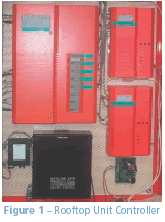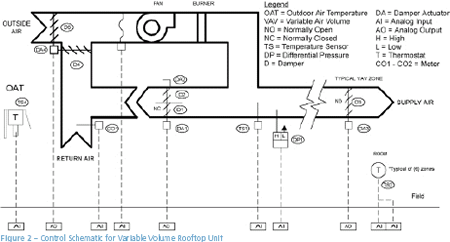ARCHIVED - Energy Efficiency in Buildings
Information Archived on the Web
Information identified as archived on the Web is for reference, research or recordkeeping purposes. It has not been altered or updated after the date of archiving. Web pages that are archived on the Web are not subject to the Government of Canada Web Standards. As per the Communications Policy of the Government of Canada, you can request alternate formats. Please "contact us" to request a format other than those available.
DDC Control Strategies for Energy Efficiency
Description

Energy conservation depends greatly on how well building heating, ventilation and airconditioning (HVAC) systems are controlled to match occupant needs. In recent years, direct digital control (DDC) systems (Figure 1), which can easily and accurately control building HVAC systems, have become so cost-effective that they are replacing manual and electromechanical controls in retrofits, and are also being installed in many new buildings.
This fact sheet looks at implementing methods of controlling air systems to minimize the amount of energy used to operate fans and preheat or cool ventilation air. It addresses three key strategies:
-
Controlling ventilation air quantities based on demand using carbon dioxide (CO2) and occupancy sensors.
-
Reducing reheat energy by automatically resetting supply air temperature.
-
Employing optimal start-up routines to bring space to temperature after a setback period.
To employ these methods, systems should be equipped with an air quality (CO2) sensor, space temperature sensors installed in various locations and occupancy sensors that can feed signals back to the central control system.
Technical Specifications
Demand Controlled Ventilation (DCV) – DCV can be achieved by various means, the most effective of which is by determining air quality by the amount of CO2. The American Society of Heating, Refrigerating and Air-Conditioning Engineers, Inc. (ASHRAE) has determined that the acceptable CO2 level of air in commercial and institutional buildings is 1000 parts per million (ppm), with outdoor air concentrations at about 400 ppm. A typical control setpoint would be 800 to 900 ppm. CO2 concentrations are measured in the return air duct for areas with similar occupancy and use, or in the controlled space. If only one sensor is used for a large area, it should be placed in the zone that is likely to have the highest occupancy. Occupancy sensors can be used as override switches to turn on the fan for a short time during a normally unoccupied period, or as indicators of occupancy during occupied periods. In an unoccupied auditorium or a gymnasium, the air system might simply maintain a minimum temperature with no ventilation. When the space is occupied, the CO2 measurement will be used to control ventilation air quantities by modulating the outside air damper from fully closed to fully open to maintain the desired CO2 level.
Supply Air Temperature Reset (SATR) for Constant Volume Air Systems – Air systems with heating and cooling usually have an economizer control to modulate outdoor air (OA) and return air (RA) dampers to bring in cooler outdoor air and avoid mechanical cooling. However, when some zones require cooling and some heating, the mixed supply air is usually controlled to a fixed temperature of, for example, 13°C (55°F). By looking at feedback from sensors in various zones, the supply air temperature can be reset to a higher value, up to 25°C (77°F). This will minimize the amount of simultaneous heating and cooling. This system requires DCV sensors in the discharge air and four to five space sensors per system to provide space temperature feedback. The control computer will look for the warmest (or coolest) zone and adjust the supply-air temperature.
Optimal Start/Stop of HVAC Systems – Under night setback or setup conditions in both heating and cooling seasons, the building setpoint can be varied during unoccupied periods. However, when the systems are turned back to occupied mode, the building air must be returned to operating temperature as quickly as possible. Because all buildings, and zones within a building, have different thermal inertia, an optimum start algorithm must be used to anticipate the latest time to turn the system back on. These algorithms look at the lowest zone temperature, the outdoor air temperature, and the time lag to heat (or cool) to the setpoint in order to improve the estimate of the start time. They then retrieve and analyse historical temperature and thermal time lag information. These same algorithms can also be used to turn off HVAC systems at the end of the day while the building is still occupied, a technique that is especially effective for buildings with high thermal inertia.

The schematic in Figure 2 shows a rooftop variable air volume control system that is instrumented for DCV operation
Comparison
It is difficult to calculate energy savings from system optimization, but they can be compared to non-optimized control systems. DCV can save up to 50 percent of fan energy and 10 percent of heating energy for a system during occupied hours. Ventilation air heating accounts for up to 30 percent of total heating energy for a commercial building. For example, a large air system (30 000 cfm) in a Toronto building set to a minimum outdoor air (OA) position of 50 percent for a typical annual schedule of 3950 hours will cost $9,700 per year at $9 per gigajoule. Reducing the OA to 25 percent will save $4,800 per year. Table 1 compares ventilation costs for different cities in Canada. Supply air reset on the same air system could increase the setpoint by up to 2°C or 25 percent of the average temperature rise (Vancouver). Night setback of heating can save from 6 to 12 percent for heavily constructed buildings, and from 16 to 32 percent for lighter constructions. Optimum start/stop can increase the setback/setup time by one to two hours per day. For a 10-hour unoccupied period, the savings can be as high as 3 to 6 percent for light constructions.
| Minimun outdoor air (percent) | Annual Ventilation Cost for 30 000-cfm Supply Air System* ($9/GJ of gas) | |||
|---|---|---|---|---|
| Vancouver | Calgary | Toronto | Montréal | |
| 50 | $ 7 200 | $ 12 400 | $ 9 700 | $ 10 500 |
| 30 | $ 3 600 | $ 6 200 | $ 4 800 | $ 5 200 |
| *For a typical heating season of 3950 hours of operating time. | ||||
Case Study
Ayr Public School, in the Waterloo Region District School Board in Ontario, is one example of a school built with a DDC control strategy (see Table 2). The 3850-m2 facility was built in 1999 at a total cost of $4,040,000. The building controls accounted for $480,000 of the total. The design includes 10 rooftop airhandling units and 44 heating/cooling control zones.
According to Craig Hynd, Board Environmental Officer, “The modern
controls make our standard design possible. With them, we can maintain comfort and administrative oversight, and keep operating costs down in a way that just wasn't possible a few years ago.”
| Hot-Water System with Thermostats |
Variable Volume Rooftop System with Zoned DDC Control | |
|---|---|---|
| Mechanical and Environmental Construction Costs | $ 830 000 | $ 480 000 |
| Annual Energy Budget | $ 54 100 | $ 43 700 |
| Air Conditioned? | No | Yes |
| Zone Comfort Control? | Limited | Yes |
| Zoned DCV, to suit occupancy? | No | Yes |
Buildings Division
Office of Energy Efficiency
Natural Resources Canada
580 Booth Street, 18th floor
Ottawa ON K1A 0E4
Tel.: 877-360-5500 (toll free)
Fax: 613-947-4121
Web site
Page details
- Date modified: